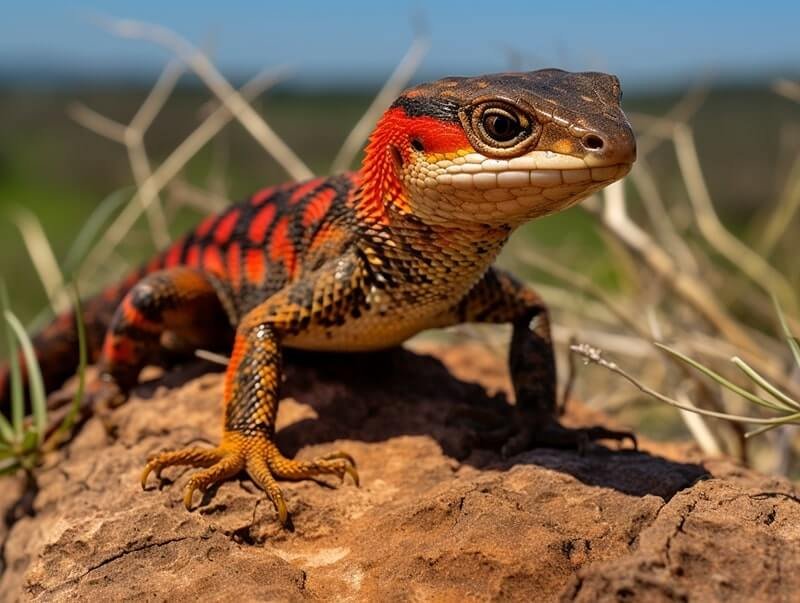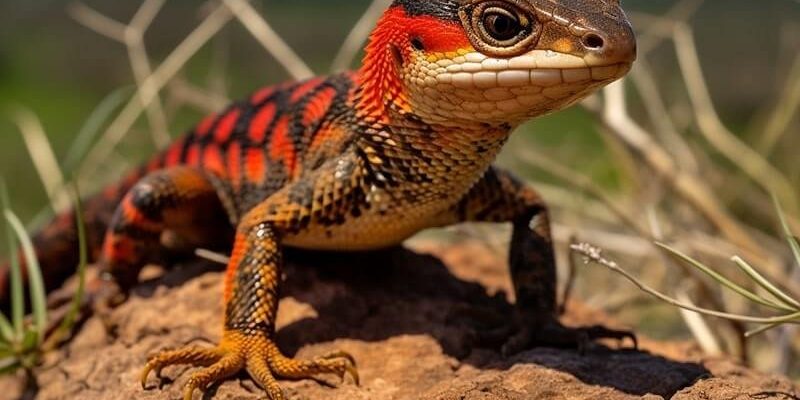
Fire skinks, or *Lamprolepis smaragdinus*, are native to Africa and are known for their striking appearance, but there’s more to them than just looks. They’re agile little creatures that blend into their environments, making them tricky to spot if you don’t know what you’re looking for. So, whether you’re a nature enthusiast or just curious about these vibrant reptiles, getting familiar with their characteristics is essential. Let’s talk about what makes a fire skink unique, how to recognize one in the wild, and some tips for spotting them easily.
Physical Characteristics of Fire Skinks
Fire skinks are like little works of art, covered in intricate designs that help them stand out in the world of reptiles. One of their most notable features is their bright coloration. Typically, these skinks have a striking red, orange, or yellow stripe running down their sides, contrasted beautifully against dark brown or black scales. This combination gives them an almost fiery appearance, which is how they got their catchy name.
In addition to their stunning colors, fire skinks have a specific body shape that’s worth noting. They have elongated bodies, with short limbs and a long tail that they can use to balance as they dart through their habitats. Their heads are relatively small but distinct, often featuring bright eyes that add to their expressive look. If you’re trying to identify one, keep an eye out for this lean and agile body type—they’re built for speed!
Habitat and Distribution
Understanding where fire skinks live can significantly increase your chances of spotting them. These lizards prefer humid, tropical regions, typically found in the forests and grasslands of West and Central Africa. They thrive in areas with plenty of leaf litter and vegetation cover, which provides them with the perfect hiding spots.
You might find them basking on rocks or tree trunks, or scurrying through the underbrush. Fire skinks are ground-dwellers, often seeking refuge in burrows or among debris like fallen leaves. If you’re exploring a forest in countries like Cameroon, Gabon, or the Democratic Republic of the Congo, keep your eyes peeled! They often prefer to stay hidden, so patience is key when searching for them.
Behavioral Traits
The personality of a fire skink can be as vibrant as its colors. These lizards tend to be secretive and somewhat elusive, often staying out of sight to avoid predators. You might spot one basking in the sun, warming itself before it dashes off into the underbrush.
Fire skinks are also known for their active nature, especially during the early morning and late afternoon, when they’re most likely to be on the move. They are typically solitary creatures, but you might occasionally see them basking together. Here’s the thing—if you do spot one, approach slowly. They can be quite skittish and will quickly retreat if they sense any disturbance.
Diet and Feeding Habits
Fire skinks are opportunistic feeders, which means they’ll eat whatever they can find. Their diet mainly consists of insects, snails, and other small invertebrates. This is why you’ll often find them in lush areas where these critters abound.
If you’re out in the wild, you might notice them foraging through leaf litter. They use their keen eyesight to spot movement and quickly snap up their next meal. This feeding strategy not only keeps them healthy but also helps control pest populations in their habitats—a win-win for all!
Tips for Spotting Fire Skinks
Now that you know what a fire skink looks like and where to find them, let’s talk about some handy tips for spotting one in the wild. Here are some things to keep in mind:
- Look at the right time: Early morning or late afternoon is often the best time to see them as they bask and go about their day.
- Be patient: Spend some time in areas where they might live, like forests with plenty of undergrowth.
- Use your eyes: Watch for movement and bright colors. Their vivid stripes can be a giveaway if you’re attentive.
- Stay quiet: Approach gently to avoid startling them; loud noises could send them scurrying away.
With these tips in mind, you’ll have a much better chance of encountering these fascinating reptiles in their natural habitat.
Conservation Status
While fire skinks are a joy to observe, it’s important to think about their conservation status. Many species, including the fire skink, face threats from habitat destruction and climate change. As forests are cleared for agriculture or urban development, these lizards lose their homes, which puts their population at risk.
Supporting wildlife conservation efforts can help protect these incredible creatures for future generations. By spreading awareness and practicing responsible eco-tourism, we can all play a part in ensuring that fire skinks continue to thrive in the wild.
Identifying a fire skink in the wild can be a delightful adventure, especially if you know what to look for. Their vibrant colors, unique behaviors, and specific habitats are all key factors that can help you spot them. Remember to be patient, observant, and respectful of their environment.
The next time you wander into a tropical paradise, keep your eyes peeled for these little gems of the reptile world. After all, there’s something magical about connecting with nature and discovering its colorful inhabitants. Happy skink spotting!

